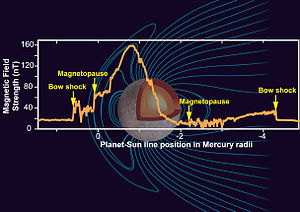 Graph showing relative strength of Mercury's magnetic field. | |
| Discovery[1] | |
|---|---|
| Discovered by | Mariner 10 |
| Discovery date | April 1974 |
| Internal field[2][3] | |
| Radius of Mercury | 2,439.7 ± 1.0 km |
| Magnetic moment | 2 to 6 × 1012 T•m3 |
| Equatorial field strength | 300 nT |
| Dipole tilt | 0.0°[4] |
| Solar wind parameters[5] | |
| Speed | 400 km/s |
| Magnetospheric parameters[6][7] | |
| Type | Intrinsic |
| Magnetopause distance | 1.4 RM |
| Magnetotail length | 10–100 RM |
| Main ions | Na+, O+, K+, Mg+, Ca+, S+, H2S+ |
| Plasma sources | Solar wind |
| Maximum particle energy | up to 50 keV |
| Aurora | |
Mercury's magnetic field is approximately a magnetic dipole, apparently global,[8] on the planet of Mercury.[9] Data from Mariner 10 led to its discovery in 1974; the spacecraft measured the field's strength as 1.1% that of Earth's magnetic field.[10] The origin of the magnetic field can be explained by dynamo theory.[11] The magnetic field is strong enough near the bow shock to slow the solar wind, which induces a magnetosphere.[12]
- ^ "MESSENGER Data from Mercury Orbit Confirms Theories, Offers Surprises". The Watchtowers. 2011-06-06. Archived from the original on 2013-02-04. Retrieved 2011-07-26.
- ^ Russell, C. T. (1992-12-03). "Magnetic Fields of the Terrestrial Planets" (PDF). UCLA – IGPP. Retrieved 2011-07-26.
- ^ Cite error: The named reference
Magnetic Field and Magnetospherewas invoked but never defined (see the help page). - ^ Williams, David, R. "Dr". Planetary Fact Sheets. NASA Goddard Space Flight Center. Archived from the original on 28 March 2014. Retrieved 6 September 2016.
{{cite web}}: CS1 maint: multiple names: authors list (link) - ^ James A. Slavin; Brian J. Anderson; Daniel N. Baker; Mehdi Benna; Scott A. Boardsen; George Gloeckler; Robert E. Gold; George C. Ho; Suzanne M. Imber; Haje Korth; Stamatios M. Krimigis; Ralph L. McNutt Jr.; Larry R. Nittler; Jim M. Raines; Menelaos Sarantos; David Schriver; Sean C. Solomon; Richard D. Starr; Pavel Trávníček; Thomas H. Zurbuchen. "MESSENGER Observations of Reconnection and Its Effects on Mercury's Magnetosphere" (PDF). University of Colorado. Retrieved 2011-07-27.
- ^ Reka Moldovan; Brian J. Anderson; Catherine L. Johnson; James A. Slavin; Haje Korth; Michael E. Purucker; Sean C. Solomon (2011). "Mercury's magnetopause and bow shock from MESSENGER observations" (PDF). EPSC – DPS. Retrieved 2011-07-26.
- ^ A. V. Lukyanov; S. Barabash; R. Lundin; P. C. Brandt (August 4, 2000). "Energetic neutral atom imaging of Mercury′s magnetosphere 2. Distribution of energetic charged particles in a compact magnetosphere – Abstract". Planetary and Space Science. 49 (14–15). Laurel, Maryland: Applied Physics Laboratory: 1677–1684. Bibcode:2001P&SS...49.1677L. doi:10.1016/S0032-0633(01)00106-4.
- ^ Williams, David R. "Planetary Fact Sheet". NASA Goddard Space Flight Center. Retrieved 2011-07-25.
- ^ Randy Russell (2009-05-29). "The Magnetic Poles of Mercury". Windows to the Universe. Retrieved 2011-07-16.
- ^ Jerry Coffey (2009-07-24). "Mercury Magnetic Field". Universe Today. Retrieved 2011-07-16.
- ^ Jon Cartwright (2007-05-04). "Molten core solves mystery of Mercury's magnetic field". Physics World. Retrieved 2011-07-16.
- ^ Randy Russell (2009-06-01). "Magnetosphere of Mercury". Windows to the Universe. Retrieved 2011-07-16.